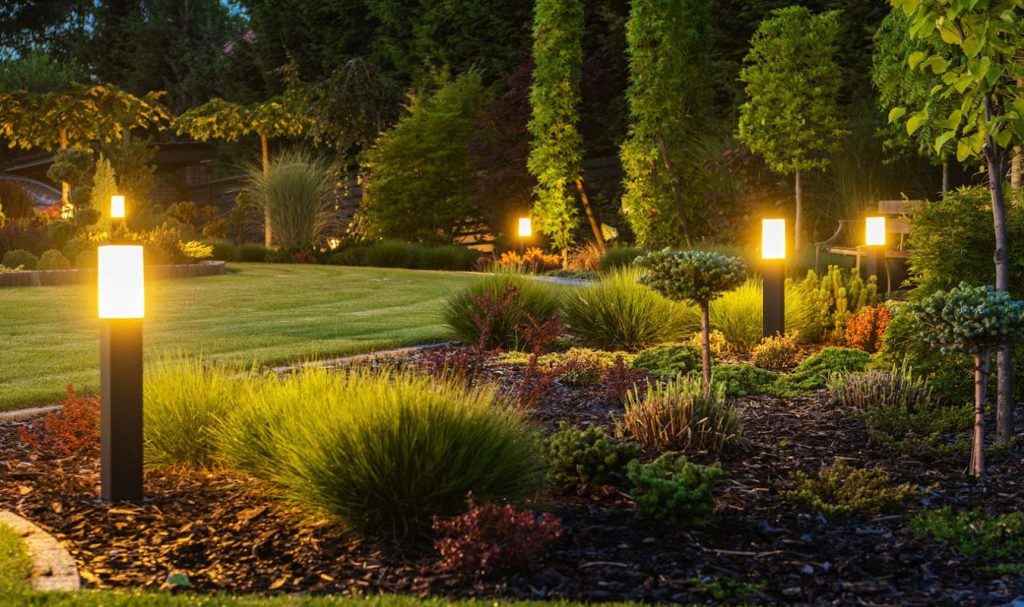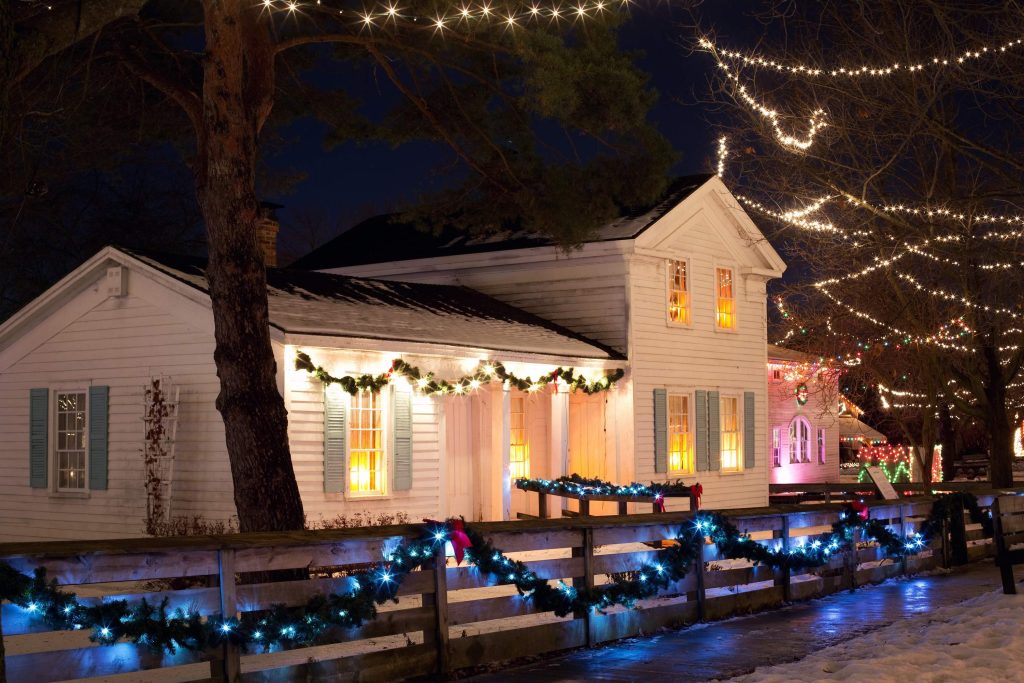Illuminating the Art of Landscape Lighting
A mélange of subtle shadows and warm light, landscape lighting is an art form itself. It is a symphony of lighting that accentuates the architectural finesse of your home and brings to life the lush greenery of your garden after sundown.
Through careful placement and selection of lights, you can create a nighttime tableau vivant that showcases water features, highlights pathways, or spotlights majestic trees. Landscape lighting goes beyond being merely decorative; it plays an instrumental role in enhancing the overall aesthetics and functionality of outdoor spaces.
Shedding Light on the Importance and Benefits
The quintessential importance of landscape lighting lies in its ability to transform nocturnal landscapes into masterpieces while ensuring safety and increasing usability. The strategic arrangement of lights creates an inviting ambience for evening soirees or tranquil solitude under a star-lit sky.
Furthermore, it provides safe passage by illuminating walkways, steps, or any potential trip hazards. Landscape lighting acts as a silent sentinel, contributing to home security. Well-lit exteriors can deter potential intruders by eliminating dark hideouts where they can lurk unnoticed. Not only does this boost your peace of mind, but it also augments property value.
By highlighting distinctive architectural features and landscaping elements using different angles or intensities of light, you add another dimension to their beauty – increases visual appeal, which in turn enhances property value. Last but not least, installing energy-efficient LED landscape lights contributes to environmental sustainability through reduced energy consumption – yet another compelling reason for considering this investment.
A Glimpse into DIY Landscape Lighting Installation
Now that we have established the significance and benefits of landscape lighting, let us ponder its feasibility as a do-it-yourself (DIY) project. Installing your own landscape lighting may seem like a daunting task, especially for beginners.
However, with a plethora of user-friendly kits available in the market, combined with the right tools and a tad bit of patience, homeowners can successfully undertake this project. It is an opportunity to unleash your creativity and customize your outdoor space as per your preferences.
Ensuring safety must be paramount when embarking on this DIY journey. Adhering to local electrical codes and taking necessary precautions minimizes risks associated with incorrect installations.
A well-executed DIY landscape lighting project brings not only aesthetic satisfaction but also a sense of accomplishment when you switch on those lights for the first time, displaying your handcrafted masterpiece. Installing your own landscape lighting is an enriching experience worthy of consideration that comes with multifaceted benefits, from enhancing visual appeal and security to contributing towards sustainability.
Understanding Landscape Lighting: Illuminating the Subtleties
Definition and Purpose of Landscape Lighting
Landscape lighting, also referred to as outdoor or garden lighting, encompasses the use of outdoor lighting for the enhancement and purposes of safety, nighttime aesthetics, accessibility, recreational usage, and sports. It is a significant component of landscape architecture and garden design. The purpose extends beyond mere aesthetics.
Properly installed landscape lighting can dramatically transform a property’s nighttime visual appeal by highlighting its architectural features and drawing attention to various parts of the landscape. Furthermore, it significantly contributes to enhancing security by deterring potential intruders and increasing visibility during the night.

Landscape lighting is often considered an art in itself as it requires an understanding of light’s interaction with physical structures and landscapes. One must carefully consider each fixture’s output, placement angle, color temperature, as well as potential shadows that may be cast in order to curate a harmonious balance between functionality and aesthetic charm.
The intent behind this form of lighting is not just about illuminating an area but designing an appealing nightscape that simultaneously provides utility and creates a mood or ambiance unique to every space. Landscape lighting installations can range from simple lit pathways leading to your home entrance to complex displays illuminating large estate grounds or commercial properties.
The incorporation of landscape lighting also adds value to properties – both tangible monetary value due to increased resale worth as well as intangible value stemming from the improved quality of life that well-illuminated spaces offer their inhabitants after dusk. In essence, landscape lighting represents a synergistic blend between artistry and practicality – a union between design considerations for visual pleasure alongside considerations for functional adequacy such as enhanced safety measures through proper lighting.
Different Types of Landscape Lighting Fixtures
Path Lights
Path lights, as implied by the name itself, are designed to illuminate pathways. They are usually installed at ground level and spread light downwards or sideways. This type of fixture is often used to ensure safe navigation through walkways and garden paths during the night. Path lights also serve the purpose of outlining boundaries – guiding visitors towards specific areas and away from delicate garden beds or water features.
Spotlights
Spotlights, on the other hand, project a concentrated beam of light onto an area or object. They are typically employed to highlight certain elements of a landscape, such as statues, trees, architectural details of buildings, or water features like fountains and ponds. Spotlights tend to emit a brighter light than most other types of outdoor lighting fixtures and therefore should be used sparingly to avoid overpowering other elements in the landscape.
Floodlights
Floodlights cast a wide beam of light that illuminates larger areas, making them ideal for enhancing security around properties. Typically more powerful than spotlights, floodlights can help deter potential intruders by eliminating dark corners where one could hide undetected.
Well Lights
Well lights provide a subtle form of lighting often installed at ground level with their glare hidden from sight – serving as an excellent choice for those desiring less conspicuous illumination options. These types of fixtures fit well with landscapes focusing on natural aesthetics, as they can easily blend with their surroundings while providing efficient lighting.
Deck/Step Lights
Deck or step lights are small fixtures designed specifically for installation within deck floors or steps. Their primary function is to increase safety by providing illumination to prevent trips and falls, but they can also add an aesthetic charm when incorporated in creative ways into decking designs.
Various Forms of Light Sources Used in Landscape Lighting: LED, Incandescent, Halogen, CFL, and more
Landscape lighting fixtures can accommodate a range of light sources, such as light-emitting diodes (LED), halogen lights, incandescent bulbs, or compact fluorescent lamps (CFLs). Each type of bulb is characterized by its own unique set of properties – ranging from energy efficiency to color temperature.
LED lights have been gaining popularity due to their superior energy efficiency and long lifespan. They are capable of producing a range of color temperatures and can be designed to emit very specific angles of light, making them highly versatile for various landscape lighting applications.
Incandescent bulbs tend to give off a soft, warm glow that creates a cozy ambiance but falls short in terms of energy efficiency and lifespan when compared to modern alternatives like LEDs.
Halogen lights offer high levels of brightness and sharpness, making them suitable for spotlighting requirements. However, they are not as energy-efficient as LEDs and tend to produce more heat, which may not be ideal in certain scenarios.
CFLs are more efficient than incandescents, but still lag behind LEDs. The choice between these different types will largely depend on your specific requirements – whether it is the desire for cost-effectiveness, longer life-span, or particular aesthetic preferences based on the quality and color tone emitted by the chosen bulb.

Installation Process: Can I Install My Own Landscape Lighting?
Assessing your Skill Level and Comfort with DIY Projects
Embarking on the journey of installing your own landscape lighting necessitates a thorough self-appraisal of one’s aptitude towards DIY tasks. The installation process involves both technical and creative skills; hence, it is paramount to be honest about your proficiency in handling tools, understanding instructions, and being patient throughout the process.
Additionally, comfort is another crucial aspect when dealing with such projects. Remember that installing landscape lighting involves working with electricity, which can pose a risk if not handled correctly. Therefore, you must assess whether you are comfortable dealing with electrical wiring or would prefer professional help.
Time Commitment Involved in Installing Your Own Landscape Lighting
Installing landscape lighting is a time-intensive endeavor. Its completion depends on several factors, including the size of your outdoor space, the complexity of the design scheme you have chosen, and how adept you are at handling such projects.
Some individuals may complete the task within a weekend, while for others it might take multiple weekends. It is necessary to take into account this significant time commitment before embarking on this project, as haste may lead to safety compromises or unsatisfactory results.
Tools needed for the Installation Process
An essential part of any successful DIY project lies in having all necessary tools at hand before starting out. For installing landscape lighting, some basic tools needed include wire strippers/cutters, screwdrivers (flathead and Phillips), a drill with various bits, including an auger bit for boring holes for fixtures and wires. For more complex installations involving buried cables, you might also need an edger or trencher tool along with safety goggles and gloves to ensure safe working conditions.
Step-by-Step Guide to Installing Your Own Landscape Lighting
Planning Your Landscape Lighting Design
Before you get started, it’s crucial to plan your landscape lighting design meticulously. Begin by identifying key areas of your garden or outdoor area that you wish to highlight. These may be features such as trees, statues, or pathways that could benefit from additional lighting.
Next, sketch out a rough plan of your garden incorporating these features and decide on the type of fixtures that would best highlight them. This can include path lights for pathways, spotlights for statues and trees, and floodlights for larger areas.
Gathering Materials and Preparing for Installation
Once you have your plan in place, it’s time to gather all the necessary materials and tools for installation. You’ll need a transformer (to convert the household voltage to a safer voltage suitable for outdoor lighting), light fixtures according to your plan, cables long enough to connect all the fixtures back to the transformer, connectors, and stakes, among others.
Safety is paramount in any DIY project, especially one involving electricity. Ensure you have safety gear like gloves and goggles at hand. Disconnect any power supply before starting work on any electrical wiring.
Installation Process
Start by installing the transformer on an exterior wall near an outdoor GFCI outlet with access to a timer if desired. Lay out your light fixtures according to your pre-defined plan without connecting them yet. Run cables from the transformer out towards each fixture location, being sure not to bury them yet in case adjustments are needed.
Connect each fixture with weatherproof wire connectors, ensuring tight connections between wires. After double-checking all connections, switch on the system briefly just to verify if everything works before finally burying cables approximately 6 inches deep in soil or lawns using a flat-edged shovel or garden edger.
Post-Installation Tips and Maintenance Advice
After successfully installing your landscape lighting system, it is essential that regular maintenance be done to ensure its longevity. This includes cleaning light fixtures, replacing old bulbs, checking cables for wear and tear, and ensuring the transformer is functioning properly.
In case of any issues, like a fixture not lighting up or extremely dim lights, troubleshoot by checking connections and possibly bulb or fixture replacements. Remember, it’s always better to seek professional help if you are unsure about electrical issues.
Conclusion: Can I Install My Own Landscape Lighting?
The journey from deciding to install your own landscape lighting system to seeing it beautifully illuminate your garden is certainly challenging but entirely feasible with careful planning, patience, and an enthusiasm for DIY projects. Not only will you gain great satisfaction from accomplishing such a project, but you will also enjoy the enchanting atmosphere that proper landscape lighting can provide in your outdoor spaces. Keep shining!
You may also be interested in the following posts:
